
The Hepialidae are a family of insects in the lepidopteran order. Moths of this family are often referred to as swift moths or ghost moths.
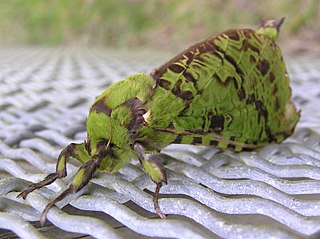
Aenetus is a genus of moths of the family Hepialidae. There are 24 described species found in Indonesia, New Guinea, New Caledonia, Australia and New Zealand. Most species have green or blue forewings and reddish hindwings, but some are predominantly brown or white. The larvae feed in the trunks of living trees, burrowing horizontally into the trunk, then vertically down.

Cladoxycanus is a monotypic genus of moths belonging to the family Hepialidae. It consists of only one species, Cladoxycanus minos, which is endemic to New Zealand. C. minos was first described by George Hudson in 1905.
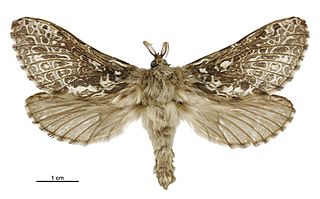
Aoraia aurimaculata is a species of moth of the family Hepialidae. It was described by Alfred Philpott in 1914 from a specimen collected at The Hermitage, Mount Cook by F. S. Oliver. This holotype specimen is now lost. A. aurimaculata is endemic to New Zealand,

Aoraia dinodes is a species of moth of the family Hepialidae. It is endemic to New Zealand. This moth was described by Edward Meyrick in 1890 from specimens collected in Invercargill by Captain Hutton.

Aoraia enysii, also known as the forest ghost moth is a species of moth of the family Hepialidae. It is endemic to New Zealand. This is the only species of the genus Aoraia that can be found in the North as well as the South Island. This species can be found from Mount Te Aroha southwards. This species was described by Arthur Gardiner Butler in 1877 from a specimen obtained in the North Island by J. D. Enys.
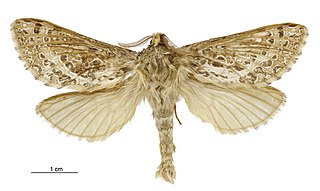
Aoraia insularis, also known as the Rakiura ghost moth, is a species of moth of the family Hepialidae. It is endemic to New Zealand and is found on only on Stewart Island and Steward Island's surrounding smaller islands. It was described by John S. Dugdale in 1994.

Aoraia lenis is a species of moth of the family Hepialidae. It is endemic to New Zealand. It was described by John S. Dugdale in 1994.

Aoraia oreobolae is a species of moth in the family Hepialidae. This species is endemic to New Zealand. It is classified as "At Risk, Naturally Uncommon" by the Department of Conservation.
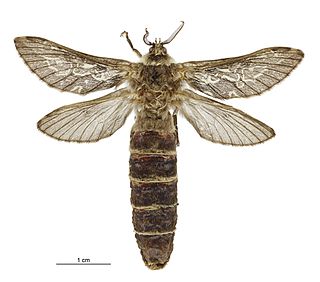
Aoraia orientalis is a species of moth of the family Hepialidae. It is endemic to New Zealand and is found in eastern Central Otago. It was described by John S. Dugdale in 1994.

Aoraia senex is a species of moth of the family Hepialidae. It is endemic to New Zealand, where it is known from the South Island. This species was first described by George Vernon Hudson in 1908 from specimens discovered by J. H. Lewis in Central Otago.

Dioxycanus fusca is a species of moth of the family Hepialidae. It is endemic to New Zealand. This species was first described by Alfred Philpott in 1914 as Porina fusca using specimens collected by C. Fenwick and M. O. Pasco. In 1966 L. J. Dumbleton reviewed New Zealand Hepialinae and placed this species within the genus Dioxycanus, giving it the new combination Dioxycanus fuscus.

Dioxycanus oreas is a species of moth of the family Hepialidae. It is endemic to New Zealand. It was first described by George Vernon Hudson in 1920. The species was discovered by Averil Lysaght.

Dumbletonius characterifer is a species of moth of the family Hepialidae. It is endemic to New Zealand. It was first described by Francis Walker in 1865.

Wiseana cervinata, a porina moth, is a species of moth belonging to the family Hepialidae. It was described by Francis Walker in 1865 and is endemic to New Zealand.

Wiseana copularis is a species of moth belonging to the family Hepialidae. It is endemic to New Zealand. This moth is one of several very similar looking species within the genus Wiseana and this group are collectively referred to as "Porina" moths. In its larvae form this species consumes pasture grasses and, if numerous, is regarded as a pest by New Zealand farmers reliant on good quality pasture for their stock.

Wiseana fuliginea is a species of moth belonging to the family Hepialidae. It was described by Arthur Gardiner Butler in 1879 and is endemic to New Zealand.

Wiseana mimica is a species of moth belonging to the family Hepialidae. It was described by Philpott in 1923, and is endemic to New Zealand.

Wiseana signata is a species of moth belonging to the family Hepialidae. It was described by Francis Walker in 1856 and is endemic to New Zealand.
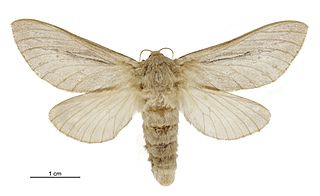
Wiseana umbraculata, also known as the bog porina, is a species of moth belonging to the family Hepialidae. There are seven endemic species and three haplotypes of Wiseana in New Zealand including bog porina. It was regarded as being common in Whanganui in the early twentieth century.



















